Meaning of "Mound Builders"—Location of Mound Building tribes—All Mounds not the work of men—Altar Mounds—Objects found on the Altars—Altar Mounds possibly burial Mounds—Burial Mounds—Mounds not the only Cemeteries of these tribes—Terraced Mounds —Cahokia Mound—Historical notice of a group of Mounds—The Etowah group—Signal Mounds—Effigy Mounds—How they represented different animals—Explanation of the Effigy Mounds—Effigy Mounds in other localities—Inclosures of the Scioto Valley—At Newark, Ohio—At Marietta, Ohio—Graded Ways—Fortified Inclosures—Ft. Ancient, Ohio—Inclosures of Northern Ohio—Works of unknown import—Ancient Canals in Missouri—Implements and Weapons of Stone—Their knowledge of Copper—Ancient mining —Ornamental pipes—Their knowledge of pottery—Of Agriculture—Government and Religion—Hard to distinguish them from the Indians.
PAST of our race is irradiated here and there by the light of science sufficiently to enable us to form quite vivid conceptions of vanished peoples. As the naturalist, from the inspection of a single bone, is enabled to determine the animal from which it was derived, though there be no longer a living representative, so the archæologist, by the aid of fragmentary remains, is able to tell us of manners and times now long since removed. In the words of another: "The scientist to-day passes up and down the valleys, and among the relics and bones of vanished people, and as he touches them with the magic wand of scientific induction, these ancient men stand upon their feet, revivified, rehabilitated, and proclaim with solemn voice the story of their nameless tribe or race, the contemporaneous animals, and physical appearance of the earth during those prehistoric ages."2
We have already learned that the world is full of mysteries, and though, by the exertion of scholars, we begin to have a clearer idea of some topics, yet our information is after all but vague and shadowy. The amount of positive knowledge in regard to the mysterious tribes of the older Stone Age, or the barbarians of the Neolithic period, or the struggling civilization of the early Metallic Ages, is lamentably deficient. On our Western Continent we have the mysterious remains in the gold-bearing gravels of the Pacific coast, the significance of which is yet in dispute. We have the Paleolithic Age of Europe, represented by the remains found in the gravels of the Delaware at Trenton, New Jersey. When deposited there, and by what people used, is, perhaps, still enshrouded in doubt.
Leaving now the past, expressed by geological terms, or by periods of thousands of years, we draw near to our own tribes, near, at least, comparatively speaking, and behold, here, also, we discern evidence that an ancient culture, as marked as that which built its cities along the fertile water-courses of the Old World, had its seat on the banks of our great rivers; that here flourished in full vigor for an unknown length of time a people whose origin and fate are yet in doubt, though, thanks to the combined efforts of many able men, we begin to have clearer ideas of their social organization. We know them only by reason of their remains, and as these principally are mounds, we call them the "Mound Builders."
The name is not a distinguishing one in every sense, since mankind, the world over, have been mound and pyramid builders. The pyramids of Egypt and the mound-dotted surface of Europe and Asia bear testimony to this saying, yet nowhere else in the world are they more plainly divided into classes, or marked with design than here. In some places fortified hills and eminences suggest the citadel of a tribe or people. Again, embankments of earth, mostly circular or square, separate and in combination, generally inclosing one or more mounds, excite our curiosity, but fail to satisfy it. Are these fading embankments the boundaries of sacred inclosures, or the fortification of a camp, or the foundations on which to build communal houses? Here graded ways, there parallel embankments raise questions, but suggest no positive answer. We are equally in doubt as to the purposes for which many of the mounds were built. Some seem to have been used as places of sepulcher, some for religious rites, and others as foundation site of buildings. Some may have been used as signal mounds, from which warning columns of smoke, or flaming fires, gave notice of an enemy's approach.
Before coming to details let us, at a glance, examine the picture as a whole. This country of ours, with its wide plains, its flowing rivers and great lakes, is said by scholars to have been the home of a people well advanced in the arts of barbarian life. What connection, if any, existed between them and the Indians, is yet unsettled. We are certain that many years before the Spanish discovery of America they made their settlements here, developed their religious ideas, and erected their singular monuments. That they were not unacquainted with war, is shown by their numerous fortified inclosures. They possessed the elements of agriculture, and we doubt not were happy and contented in their homes. We are certain they held possession of the fairer portions of this country for many years.
We must now seek to gather more particular knowledge of them, and of the remains of their industry. We must not forget that these are the antiquities of our own country; that the broken archæological fragments we pick up will, when put together, give us a knowledge of tribes that lived here when civilization was struggling into being in the East. It should be to us far more interesting than the history of the land of the Pharaohs, or of storied Greece. Yet, strange to say, the facts we have just mentioned are unknown to the mass of our people. Accustomed to regard this as the New World, they have turned their attention to Europe and the East when they would learn of prehistoric times. In a general way, we have regarded the Indians as a late arrival from Asia, and cared but little for their early history. It is only recently that we have become convinced of an extended, past in the history of this country, and it is only of late that able writers have brought to our attention the wonders of an ancient culture, and shown us the footprints of a vanished people.
We must first try and locate the territory occupied by the remains of the mound builders. They are not to be found broadcast over the whole country. We recall, in this connection, that the early civilization of the East arose in fertile river valleys. This is found to be everywhere the case, so we are not surprised to learn that the broad and fertile valley of the Mississippi, with its numerous tributaries, was the territory where these mysterious people reared their monuments and developed their barbarian culture. Throughout the greater portion of this area we find numerous evidences of a prolonged occupation of the country. We are amazed at the number and magnitude of the remains. Though this section has been under cultivation for many years, and the plow has been remorselessly driven over the ancient embankments, yet enough remain to excite our curiosity and to amply repay investigation.
This portion of the United States seems to have been the home, the seat of the mound building tribes. We can not expect to find one type of remains scattered over this entire section of country. Indeed, to judge from the difference of the remains, they must have been the work of different people or tribes, who were doubtless possessed of different degrees of culture.3 We will notice in our examination how these remains vary in different sections of the country. But it is noticeable that these remains become scarce and finally disappear as we go north, east, and west from the great valley. Although they are numerous in the Gulf States, yet they are not to be found, except in a few cases, in States bordering on the Atlantic.4 Some wandering bands, perhaps colonies from the main body of the people, established works on the Wateree River, in South Carolina,5 In the mountainous regions of North Carolina occur mines of mica, which article was much prized by the mound builders; and here also are to be found traces of their early presence.6 We do not know of any authentic remains in New England States. In Western New York there exists a class of remains which, though once supposed to be the work of these people, are now generally considered as the remains of works erected by the Indians,7 and of a similar origin appears to have been the singular fortification near Lake Winnipiseogee, in New Hampshire.8
We have no record of their presence north of the great lakes. Passing now to the western part of the valley, we do not find definite traces of their presence in Texas. On this point, however, some authors state the contrary, apparently basing their views on a class of mounds mentioned by Prof. Forshey.9 But the very description given of these mounds, and the statements as to the immense number of them,10 seem to show they are not the work of men.11 We do not think the West, and especially the North-west, has been carefully enough explored to state where they begin. It is certain that the head waters of the Mississippi and the Missouri were thickly settled with tribes of this people, and some writers think that they spread over the country by way of the Missouri Valley from the North-west. Mr. Bancroft quotes from the writings of Mr. Dean, to show the existence of mounds and inclosures on Vancouver Island, and in British Columbia. And the statement is made that a hundred miles north of Victoria there is a group of mounds ranging from five to fifty yards in circumference, and from a few feet to fifty feet in height.12
The inclosures, however, are described as being very similar to those in Western New York, and are probably simply fortified sites, common among rude people the world over, and such as were often erected by Indians. The remains on the upper Missouri and its tributaries are very numerous, and to judge from the brief description given us of them, they must be very interesting.13 This section has, however, been too little explored to speak with confidence of these works.
As showing how much care should be exercised in this matter, we refer to the account given by Capt. Wilkes in his journal of the United States exploring expedition. Speaking of the mounds on the gravelly plains between the Columbia River and Puget Sound, he tells us that the Butte Prairies are covered with small mounds at regular distances asunder. Some of them are thirty feet in diameter, six or seven feet above the level of the ground, and many thousands in number. He opened some of them, and found a pavement of round stones, and he thought he could detect an arrangement of the mounds in groups of five, thus.
It was his impression that they were the works of men, and had been constructed successively and at intervals of several years.14 This observation of Capt. Wilkes is referred to by many as evidence of the former existence of Mound Builders in this section.
More careful research in recent times has established the fact that these mounds were certainly not erected by human hands, and no one else has been able to discover the supposed arrangement in groups of five. The pavement of round stones is common to the whole prairie.
But the greatest objection is the number of the mounds. A population larger than could have found a living in the country must have been required to erect them, unless we assume that a great length of time was consumed in this work. Some other explanation must be given for these mounds, as well as for those mysterious ones mentioned by Prof. Forshey. This cut gives us a fair idea of the scenery of this section and the mounds.15
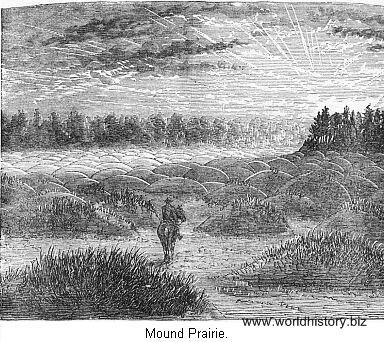
Within the area we have thus defined are located the works of the people we call the Mound Builders. What we wish to do is to learn all about these vanished people. A great many scholars have written about them, and large collections of the remains of their handiwork have been made. There is, however, a great diversity of opinion respecting the Mound Builders and their culture. So we see we have a difficult subject to treat of. In order to gain a clear understanding of it, we must describe the remains more closely. About all we can learn of these people is from a study of their monuments. We can not call to our aid history or tradition, or rock-carved inscription, but must resort to crumbling mounds, broken down embankments; study their location, and observe their forms. To the studies in the field we must add those in the cabinet, and examine the many objects found in and above the mounds and earth-works, as well as the skeletons of the builders of the works. Rightly used, we can draw from these sources much valuable information of the people whose council-fires blazed all along the beautiful valleys of the Ohio and Mississippi rivers in times far removed from us.
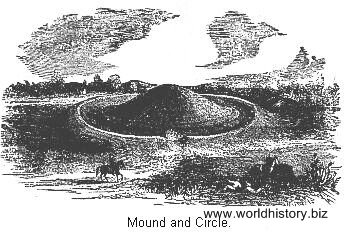
We will first speak of the simplest form of these works, the ordinary conical mound. This is the one form found all over the extensive area designated. They exist in great numbers on the banks of the upper Missouri, as well as the river bottoms of the South. This cut represents a very fine specimen of a mound, in this instance surrounded by a circular embankment. We must not forget that mounds are found all over the world. "They are scattered over India, they dot the steppes of Siberia and the vast region north of the Black Sea; they line the shores of the Bosphorus and the Mediterranean; they are found in old Scandinavia, and are singularly numerous in the British Islands."16
The principle in human nature which leads to the erection of mounds is living and active to-day. The shaft which surmounts Bunker Hill is but a modern way of memorizing an event which in earlier ages would have led to the erection of a mound, and the polished monument which marks the resting place of some distinguished man was raised for the same purpose as the mounds heaped over the chiefs and warriors of another age. The feeling which moves us to crown with steeples or spires our houses of worship is evidently akin to that which induced older races to erect a mound on which to place their temples, their idols, and altars of sacrifice.
If mounds were the only works remaining of these ancient people, we would not take so great an interest in them, and, as it is, we are not to suppose that all the mounds are the works of those people we call the Mound Builders. Recent investigation and historical evidence unite in showing that some comparatively recent Indian tribes formed and used mound structures. Early explorers have left abundant testimony to show that in many cases the Indians resorted to mound-burial. Thus, it seems that it was the custom of the Iroquois every eighth or tenth year, or whenever about to abandon a locality, to gather together the bones of their dead and rear over them a mound. To this custom, which was not confined to the Iroquois, are doubtless to be ascribed the barrows and bone mounds which have been found in such numbers in various parts of the country.17 Although it is well to bear these facts in mind, yet it is not doubted that the larger number, and especially the more massive ones, were erected by the same people who built the other mysterious works, and so it is necessary that they be carefully studied.

In the valley of the Ohio there have been found a class of mounds known as Altar Mounds. These, it should be stated, nearly always occur in or near inclosures. This cut gives us a good idea of mounds of this kind. Near the top is seen an instance of what is called "intrusive" burial. After the mound was completed it had been dug into and a body buried near the surface. This burial was evidently later in time, and had no connection with the purpose for which the mound was originally built. We also notice in this mound the different layers of which it was composed. These layers are of gravel, earth, and sand, the latter being only a few inches thick. Mounds made in this manner are called stratified mounds, and all altar mounds are probably of this kind. The lines of stratification have been described as curving so as to correspond with the shape of the mound, and such we are told is the general rule.18
The peculiar feature, however, is the altar at the bottom of the mound, directly above the natural surface of the ground. The small cut gives us a clear idea of the altar, the light lines running around it showing the plan. These altars are almost always composed of clay, though some of stone have been discovered. They are of various shapes and sizes. We notice the dish-shaped depression on the top of the altar. The clay of which they are composed seems to have been moulded into shape directly over the surface of the ground. Sometimes a layer of sand was put down as a foundation. They are nearly always thoroughly burned, the clay being baked hard, sometimes to the depth of fifteen or twenty inches. This must have required intense and long continued heat.
We are at once curious to know the object of this altar. Within the basin-shaped depression are generally found all manner of remains. Sometimes portions of bones, or fragments of wood, arranged in regular order; pieces of pottery vessels, and implements of copper and stone; spear-heads, arrow-heads, and fragments of quartz and crystals of garnet. Pipes are a common find, carved in miniature figures of animals, birds, and reptiles. Two altar-mounds but recently examined near Cincinnati had altars about four feet square that were loaded down with ornaments.
One especially contained quantities of ornaments of stone, copper, mica, shells, the canine-teeth of bears and other animals, and thousands of pearls. They were nearly all perforated, as if for suspension. Several of the copper ornaments were covered with native silver which had been hammered out into thin sheets and folded over the copper. One small copper pendant seems to have been covered with a thin sheet of hammered gold, as a small piece was still clinging to it. This is the first example of finding native gold in the mounds.19 On this altar were also found masses of meteoric iron, and ornaments of the same material. One piece of mica showed the profile of a face.20
In all cases the articles found on the altars show the action of fire. We seem justified, then, in supposing that after the altar was formed, fires were lit on them, and into this fire were thrown the various articles just enumerated. But what was all this for? This will probably never be very clear to us, beyond the fact that it was a religious rite. Portions of the human skeleton have been found on these altars, and it has been suggested that human victims were at times part of the sacrifice; but as it is known that this people practised cremation, it may be that the altars were sometimes used for that purpose, the remains being afterwards gathered and buried elsewhere.
After the offerings had been flung into the fire, while it was yet glowing on the altar, earth or sand was heaped over them for a few inches, then successive layers of earth and sand, or ashes, clay, or gravel. Sometimes the altars were used several different times, in which case a layer of clay several inches thick was laid over the old altar. In one case three layers had been burned in before the final addition of earth and sand were heaped over it. These strange monuments of a by-gone people hint to us of mysterious rites. We wish we had more positive knowledge of the ceremonies they commemorated; but at present we must rest satisfied with conjecture.
The next class of mounds are known as burial mounds, some of which are stratified, and resemble the so-called altar mounds. A mound explored in Butler County, Ohio, had in the center a layer of clay an inch thick, which had been burned until it was red. Underneath this was another layer of clay, beneath which was found charcoal, burnt cloth, and charred bones. Mr. Foster thinks that in this mound the body was placed on a rude altar, fires were lit, and that while yet burning, clay was thrown over it all, and that then fires were built all over the mound, sufficient to burn the clay for an inch in thickness.21 We have also a description of a group of mounds explored near the Mississippi River, in which there were evident signs of cremation. At least in several mounds fires had been built close above the bodies. But in cremation other victims may have been burned to accompany the departed chiefs or warriors. In one mound evidence of such a custom was observed.
In another mound the center was found to be a mass of burned clay interspersed with calcined human bones. No less than ten or fifteen bodies had been burned here. "They must have worshiped some fierce ideal deity, and the ceremony must have been considered of great importance to have required so many victims." This may have been, however, nothing more than simple cremation.22
Pidgeon has described mounds in Minnesota, in many respects like the altar mounds. In one case he mentions there was an altar or pavement of stone on the original surface of the ground, a few feet above which was a layer of clay, showing the action of fierce and long-continued fires. We furthermore are told that cremation, especially of chiefs, was more or less common among the Village Indians of North America, that similar usage was observed among many of the tribes of Mexico, and that the Mayas, of Yucatan, burnt the bodies of their lords, and built temples over their remains. So it may be that the altar mounds are but varieties of funeral mounds, the remains of the bodies burned here being buried elsewhere.23
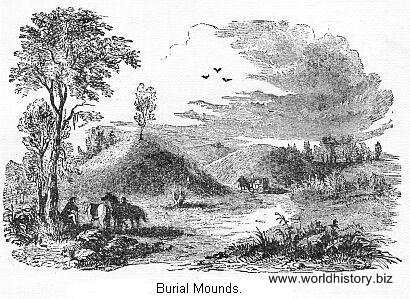
The nations that celebrated their mysteries around these mounds have long since departed; the altar fires long since burned low. We are not sure that we understand their purport, but we are certain they were regarded as of great importance, and we can readily imagine that when the fires were lit on the altars, gathering crowds stood round, and participated in the religious observance, throwing into the fire their most valued ornaments, in this manner paying their last respects to the departed chiefs and great men of their tribe.
The true burial mounds are very numerous, an comprise by far the larger number of mounds. They are to be found all over the Mound Builders' territory, and are about the only class of remains found in the prairie regions of the West. From the upper waters of the Missouri and the great lakes on the north to the Gulf States on the south, and from west of the Mississippi to the Alleghenies of the East, in all this vast region they are the prevailing class of remains, and occur by hundreds, and even thousands, along the valleys. The mounds themselves are often not very conspicuous; as a rule they are simply heaps of dirt raised above the surface and rounded over, and from two or three to fifteen or twenty feet high, although many are of much larger size. They are seldom found on the lower, or recent river terrace, but are common on the upper terrace, and are often built upon the high bluffs bordering the streams, where a wide stretch of country is exposed to view. Black-bird, an Omaha chief, who died about the year 1800, desired to be buried on a high bluff overlooking the Missouri, so that he might see the boats passing up and down the river. Perhaps from a similar superstitious wish the Mound Builders sometimes chose the sites of their burial mounds where they could watch over their country; or it may be that the monuments over the dead were placed in such conspicuous positions that they might be readily seen by the people.
The next cut represents an ordinary burial mound, which was explored by tunneling in from one side. We notice there are no different layers or stratifications in this case. In some cases, at least, the building of such a mound occupied several years. We can see where the dirt was thrown down in small quantities, averaging about a peck, as if from a basket. In one case grass had started to grow on the unfinished surface of the mound, to be covered up by fresh dirt.24
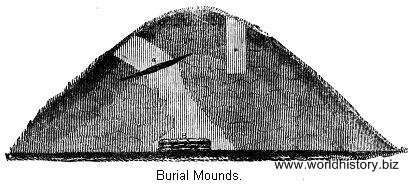
In the majority of cases the mounds contain the remains of but one individual, with various relics of a rude and barbarous people. Where but one body was buried, the usual mode of procedure seems to have been to first clear a space on the surface of the ground; the body was then placed in the center of this prepared place, and often a rude framework of timber was placed around it, sometimes a stone chamber was built up. Over this the mound was erected to the desired height. This description would apply to nearly all of the many thousands of burial mounds in the country.
In the cut a layer of charcoal is noticed near the top. Nearly all mounds show evidence of the existence of fire during some period of their construction. In some cases these fires were fierce and long continued, as if the object had been to cremate the body. It may have been a part of their religious belief that it was necessary to keep fires blazing on the mound for a short length of time to keep off evil spirits, or to comfort the soul of the departed. Such at any rate was the custom among some Indian tribes. We are told that among the Iroquois, a "fire was built upon the grave at night to enable the spirit to prepare its food."25
In some cases, many individuals were buried in the same mound. These may be communal burials, such as we have already referred to. Mounds of this kind have been examined near Nashville, Tennessee. One mound alone was the burial place of over two hundred persons. Pidgeon describes some triangular burial mounds in Minnesota, differing in shape only from the ordinary circular mounds that belong to this division. In general, burial mounds are not very high, yet there are exceptions to this rule.
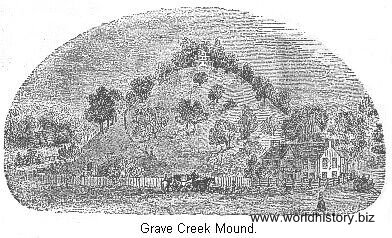
This cut represents one of the largest of these mounds. It is situated at the junction of Grave Creek and the Ohio River, twelve miles below Wheeling, in West Virginia. It measures seventy feet in height, and its base is nearly one thousand feet in circumference. An excavation made from the top downward, and from one side of the base to the center, disclosed the fact that the mound contained two sepulchral chambers, one at the base and one near the center of the mound. These chambers had been constructed of logs, and covered with stone. The lower chamber contained two skeletons, one of which is supposed to have been a female. The upper chamber contained but one skeleton. In addition to these, there were found a great number of shell beads, ornaments of mica, and bracelets of copper.26
A moment's thought will show us what a great work such a mound must have been for a people destitute of metallic tools and domestic animals. The earth for its construction was probably scraped up from the surface and brought thither in baskets. A people capable of erecting such a monument as this, with only such scanty means at their command, must have possessed those qualities which would sooner or later have brought them civilization.
Another very interesting mound of this class once stood in the city of St. Louis. The rapidly growing city demanded its removal in 1869. It was an oblong mound, one hundred and fifty feet long by thirty in height. In its removal it was shown that it contained a burial chamber seventy-five feet long, from eight to twelve feet wide, and from eight to ten feet high, in which about thirty burials had taken place. The surface of the ground had first been leveled, then the walls raised to the desired height, made firm and solid, and plastered with clay. Timbers formed the roof, over which the mound had been raised to the desired height.
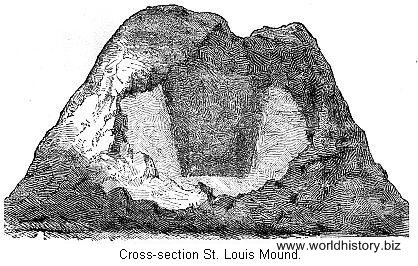
In process of time the roof decayed and fell in, thus giving a sunken appearance to the top of the mound. This view is a cross section of the mound as it was revealed by the workmen. We notice where the roof has fallen in, and the outline of the interior chamber. This burial chamber was perhaps an exact model of the cabins in which the people lived. Can it be that this mound was the final resting place of some renowned chief, and that the other bodies were those of his attendants sent to accompany him to the other world? This is perhaps as reasonable a conjecture as any. Certain it is that this tumulus and that at Grave Creek were fit pyramids for the Pharaohs of the New World.
It is not to be supposed that the mounds were the sole cemeteries of the people who built them. Like the barrows of Europe, they were probably erected only over the bodies of the chiefs and priests, the wise men, and warriors of the tribe. The amount of work required for the erection of a mound was too great to provide one for every person. The greater number of the dead were deposited elsewhere than in mounds, but it is doubtful whether we can always distinguish the prehistoric burial places from those of the later Indians. An ancient cemetery, discovered near Madisonville, Ohio, proved to be a most interesting find, as it was thought to be a burial place of the Mound Builders,27 but it seems there is strong doubt on this point. One writer thinks this was a cemetery of the Erie tribe of Indians, and not very ancient in date.28
In Tennessee are to be found numerous burial places known as the stone-grave cemeteries. Stone graves of a similar character are found in Kentucky, Ohio, and Missouri. These are as yet but few facts which can be used as indicating that all the stone graves are of one people. Many of these cemeteries are of great antiquity, while similar stone graves are of quite recent date. In some places the cemeteries cover very large areas.
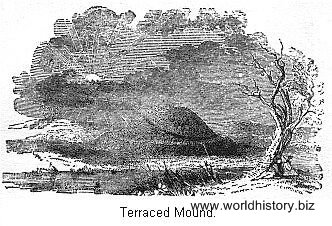
We have now to describe a class of mounds that are always regarded with great interest, as a number of our scholars think they see in them the connecting link between the remains in this country and those of Mexico and the South. These are generally known as "temple mounds," from the common impression that they were sites of temples or public buildings. In general terms, mounds of this class are distinguished by their large size and regularity of form, and they always have a flat or level top. On one side there is generally a graded way leading up to the summit, in some instances several such methods of approach. Sometimes the sides of the mound are terraced off into separate stages.29
We have already noticed that different sections of country are distinguished by different classes of mound remains. In the present State of Ohio are found many altar mounds and inclosures. In the West are large numbers of burial mounds, but the so-called temple mounds are most numerous in the South. At one place in Wisconsin is found a low embankment inclosing four low mounds with leveled tops. But the resemblance between these and the regular temple mounds is certainly slight. Only a few instances of these flat-topped mounds are found in Ohio. Of these the still existing "elevated squares" at Marietta are good examples.
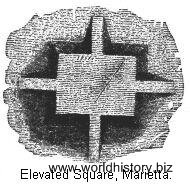
This cut represents the mound preserved in the park at Marietta. It is ten feet high, one hundred and eighty-eight feet long, by one hundred and thirty-two feet wide. The platform on the top has an area of about half an acre. Graded ways lead up on each of the four sides. These grades are twenty-five feet wide, and sixty feet long.30
As we approach the Gulf States, these platform mounds increase in number. The best representative of this class, the most stupendous example of mound builders' work in this country, is situated in Illinois, not far from St. Louis. The mound and its surroundings are so interesting that they deserve special mention. One of the most fertile sections of Illinois is that extending along the Mississippi from the Kaskaskia to the Cahokia river, about eighty miles in length, and five in breadth. Well watered, and not often overflowed by the Mississippi, it is such a fertile and valuable tract that it has received the name of the "Great American Bottom." It is well known that the Mound Builders chose the most fertile spots for their settlements, and it is therefore not surprising to find the evidence that this was a thickly settled portion of their territory. Mr. Breckenridge, writing in 1811, says: "The great number of mounds, and the astonishing quantity of human bones, everywhere dug up or found on the surface of the ground, with a thousand other appearances, announces that this valley was at one time filled with habitations and villages. The whole face of the bluff, or hill, which bounds it on the east, appears to have been a continuous burying ground."31
Mounds are numerous in this section. We learn that there are two groups of mounds or pyramids, one about ten miles above the Cahokia, and the other about the same distance below it, more than one hundred and fifty in all. Speaking of the group above the Cahokia, Mr. Breckenridge says: "I found myself in the midst of a group of mounds mostly of a circular shape, and, at a distance, resembling enormous hay-stacks scattered through a meadow. One of the largest which I ascended was about two hundred paces in circumference at the bottom, the form nearly square, though it had evidently undergone considerable alteration from the washing of rains. The top was level, with an area sufficient to contain several hundred men." He represents the view from the top of the mound to be a very extensive and beautiful one. From this elevation he counted forty-five mounds or pyramids, besides a great number of small artificial elevations. This group was arranged in the form of a semicircle, about a mile in extent, the open space being on the river.
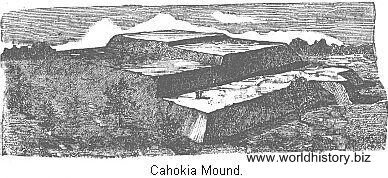
Three miles above occurs the group in which is found the famous big mound.32 This cut gives us a good idea of the mound as it was in its perfect state. All accounts given of this mound vary. From a cut of the model, as prepared by Dr. Patrick, the area of the base is a trifle over fifteen acres.33 The ascent was probably on the south side of the mound, where the little projection is seen. The first platform is reached at the height of about fifty feet. This platform has an area of not far from two and four-fifth acres. Large enough for quite a number of houses, if such was the purpose for which this mound was erected. The second platform is reached at about the height of seventy-five feet, and contains about one and three-fourth acres. The third platform is elevated ninety-six or ninety-seven feet, while the last one is not far from one hundred feet above the plain. The area of the last two is about three-fourths of an acre each. The areas of all the platforms are not far from six acres. We require to dwell on these facts a moment before we realize what a stupendous piece of work this is. The base is larger than that of the Great Pyramid,34 and we must not lose sight of the fact that the earth for its construction was scraped up and brought thither without the aid of metallic tools or beasts of burden, and yet the earth was obtained somewhere and piled up over an area of fifteen acres in one place to a height of one hundred feet, and even the lowest platform is fifty feet above the plain. Some have suggested that it might be partly a natural elevation. There seems to be, however, no good reason for such suggestions.
What motive induced the people to expend so much labor on this mound? It is not probable that this was a burial mound, though it may ultimately prove to be so. The most probable supposition is that the mound was erected so as to secure an elevated site, perhaps for purpose of defense, as on these platforms there was abundant room for a large village, and an elevation or height has always been an important factor in defenses. In this connection, Prof. Putnam has called our attention to a fact which indicates that a very long time was occupied in the construction of the mound, and further, that a numerous population had utilized its platforms as house sites—that is, that "everywhere in the gullies, and over the broken surface of the mounds, mixed with the earth of which it is composed, are quantities of broken vessels of clay, flint chips, arrow-heads, charcoal, bones of animals, etc., apparently the refuse of a numerous people." The majority of writers, however, think that this elevated site, obtained as the result of so much labor, was utilized for important public buildings, presumedly the temple of their gods, and no one can help noticing the similarity between this structure and those raised by the ancient Mexicans for both religious purposes and town sites.
Mr. Foster thinks that "upon this platform was reared a capacious temple, within whose walls the high-priests gathered from different quarters at stated seasons, celebrated their mystic rites, while the swarming multitudes below looked up with mute adoration."35 Mr. Breckenridge, whose writings we have already referred to, at the time of his first visit, "everywhere observed a great number of small elevations of earth, to the height of a few feet, at regular distances apart, which appeared to observe some order: near them pieces of flint and fragments of earthen vessels." From this he concludes that here was a populous town, and that this mound was a temple site. It is doubtful whether we shall ever pierce the veil that lies between us and this aboriginal structure. The pyramids of the Old World have yielded up their secret, and we behold in them the tombs of Egypt's kings. But this earthen pyramid on the western prairie is more involved in mystery, and we do not know even its builders. If the result of religious zeal, we may be sure that a religion which exacted from its votaries the erection of such a stupendous piece of work was one of great power.
As before remarked, "temple mounds" increase in numbers and importance as we go south. In Kentucky they are more frequent than in the States north of the Ohio River, and in Tennessee and Mississippi they are still more abundant.36 We also learn that they are often surrounded, or nearly so, with moats or ditches, as if to fortify their location. Our next cut illustrates such an arrangement—a circular wall of earth four feet high and two thousand three hundred feet in circumference, incloses four mounds, two of which are temple mounds. According to the late Prof. Forshey, temple mounds abound in Louisiana. He described a group situated in Catahoola County, in which the principal mound has a base of more than an acre, a height of forty-two feet, and the upper platform an area of nearly one-third of an acre. The smaller mounds are arranged around this larger one. This group is defended by an embankment. From this point for a distance of twenty miles along the river, are scattered similar groups of mounds; in all cases the smaller ones arranged around the larger one, which is presumably the site of a temple.
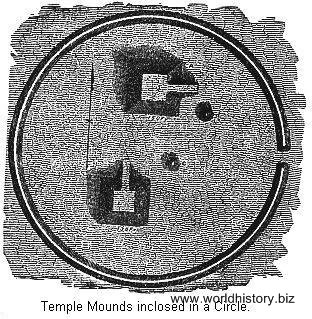
A digression right here may not be devoid of interest. We are not sure but that the dim, uncertain light of history falls on the origin of this group of mounds. When the French first commenced their settlement in the lower Mississippi Valley, the Natchez Indians was the most powerful tribe in all that section. In the course of time, wars ensued between them and the French, and in the year 1730 they fled into Upper Louisiana, and settled at the place where these mounds are now found. But the French followed them a year or so afterwards, and nearly exterminated. them. Some of our scholars think that they erected these mounds.37 The historian of that epoch simply says they had "built a fort there." It is however questioned whether they had time to build works of such magnitude. But they were both a mound-building and a mound-using people, and we are not prepared to say how long it would take them to do the work, until we know the number engaged, methods employed, and other considerations.38 If they did not build these works, they doubtless cleared them of trees and utilized them; and this place was therefore the scene of the final downfall of the Natchez—a people we have every reason to regard as intimately connected with the prehistoric mound-building tribes.
The largest temple mound in the South is near Seltzertown, Mississippi. Its base covers about six acres, and it rises forty feet. This slope was ascended by means of a graded way. The summit platform has an extent of nearly four acres. On this platform three other mounds had been reared—one at each end, and a third in the center. Recent investigation by the Bureau of Ethnology have shown that the base of this mound is a natural formation. Lumps of sun-dried, or partially burnt clay, used as plastering on the houses of the Mound Builders, gave rise to a sensational account of a wall of sun-dried bricks two feet thick, supporting the mound on the northern side.39 The famous Messier Mound, in Georgia, is said to reach a height of ninety-five feet. But a large part of this elevation is a natural eminence; the artificial part is only a little over fifty feet.
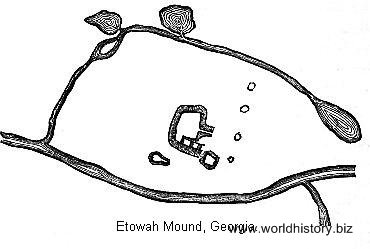
A work of unusual interest occurs on the Etowah River, Georgia. This cut gives us a plan of the work. We notice, first of all, the moat or ditch by which they fortified their position. The ditch is still from five to twenty-five feet deep, and from twenty to seventy-five feet wide. It connects directly with the river at one end, but stops short at the other. It surrounds nearly fifty acres of land. At two points we notice reservoirs, each about an acre in size, and an average depth of not less than twenty feet. At its upper end is an artificial pond. This ditch, with its reservoirs and pond, is no slight work. The large mound seen in the center of the space is one of the largest of the temple mounds. Its shape is sufficiently shown in the cut. The height of the mound is sixty-five feet. We call especial attention to the series of terraces leading up the south side of the mound. Graded ways afford means of access from one terrace to the other. A pathway is also seen on the eastern side.
To this group of works an interest attaches similar to that of the group of works mentioned in Louisiana. We are not certain but that we catch a glimpse of it while it was yet an inhabited Indian town. This is contained in the brief accounts we have of the wanderings of the unfortunate De Soto and his command. One of the chroniclers of this expedition La Vega, describes one of the towns where the weary Spaniards rested, and which we are sure was somewhere in Northern Georgia, in such terms, mentioning the graded way leading to the top, that Prof. Thomas, who has spent some time in this investigation, thinks his description can apply only to the mound under consideration.40 Whether this conclusion will be allowed to stand, remains to be seen. But, if true, then the darkness which rests upon this aboriginal structure lifts for a moment and we see around it a populous Indian town, able to send five hundred warriors to battle. The Spaniards marched on to sufferings and death, and darkness again closed around the Etowah Mound. When the Europeans next beheld it around it was the silent wilderness; the warriors had departed; the trees of the forest overspread it.
We have now described the principal mound structures, and shown the different classes into which they are divided. But a large class of mounds are found scattered all through the Mound Builders' territory that were probably used as signal mounds. Burial mounds were also often used for this purpose.41 This was because their location was always very favorable for signal purposes. Signaling by fire is a very ancient custom. The Indians on our western plains convey intelligence by this means at the present day. Some tribes use such materials as will cause different shades of smoke, using dried grass for the lightest, pine leaves for the darkest, and a mixture for intermediate purposes. They also vary the signal by letting the smoke rise in an unbroken column, or cover the fire with a blanket, so as to cause puffs of smoke. The evidence gathered from the position of the mounds, and traces of fire on their summit, is that the Mound Builders had a very extensive system of signal mounds.
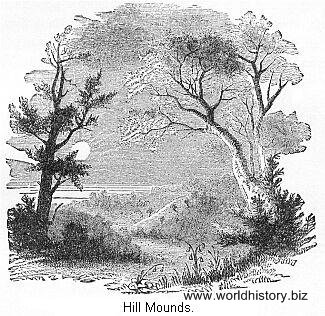
To illustrate this system, we would state that the city of Newark, Ohio, was the site of a very extensive settlement of the Mound Builders. This settlement was in a valley, but on all the surrounding hills were located signal mounds. And it is further stated that lines of signal mounds can be traced from here as a center to other and more distant points. The large mound at Mt. Vernon, twenty miles to the north, was part of this system. As the settlements of the Mound Builders were mostly in river valleys, we would expect to find all along on the bluffs fronting these valleys traces of signal mounds. In the Scioto Valley, from Columbus to Chillicothe, a distance of about forty miles, twenty mounds "may be selected, so placed in respect to each other that it is believed, if the country was cleared of forests, signals of fire might be transmitted in a few minutes along the whole line." Some think the chain is much more extensive than this, and that the whole Scioto Valley, from Delaware County to Portsmouth, was so provided with mounds that signals could be sent in a very few minutes the whole distance.42
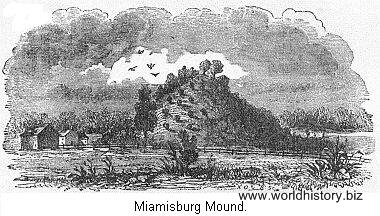
The valley of the Miami River was equally well provided with signal mounds. This great mound, at Miamisburg, Ohio, rising to the height of sixty-eight feet, was one of the chain by which signals were transmitted along the valley. Not only was each river valley thus provided, but there is evidence that communication was established between different river systems, so we can easily see how quickly the invasion of their country by an enemy from any quarter would become known in widely scattered sections. Immediately across the river from Chillicothe, Ohio, on a hill nearly six hundred feet high, was located a signal mound. A fire built upon it would be visible twenty miles up the valley, and an equal distance down. It would be also visible far down the valley of Paint Creek. Some think that such a system of lofty observatories extended across the whole State of Ohio, of Indiana, and Illinois, the Grave Creek mound, on the east, the great mound at Cahokia, on the west, and the works in Ohio filling up the line. We do not believe, however, it is safe to draw such conclusions. It is doubtful whether there was any very close connection between the tribes in these several sections.
In the State of Wisconsin are found some of the most interesting remains of the Mound Builders. They are so different from the ordinary remains found elsewhere that we must admit that the people who built them differed greatly from the tribes who built the great temple mounds of the South, or the earthworks of Ohio. The remains in Wisconsin are distinguished not by their great size or height, but by their singular forms. Here the mound building instincts of the people were expressed by heaping up the earth in the shape of animals. What strange fancy it was that led them to mould the figures on the bluffy banks of the rivers and the high lands about the lakes of their country, we shall perhaps never know. That they had some design in this matter is, of course, evident, and if we would try and learn their secret, we must address ourselves to a study of the remains.
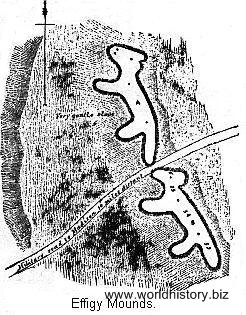
Effigy mounds are almost exclusively confined to the State of Wisconsin. We, indeed, find effigy mounds in other sections, but they are of rare occurrence.43 They, however, show that the same reasons, religious, or otherwise, exists in other localities, while in the area covered by the southern portion of the State of Wisconsin it found its greatest expression. This cut affords us a fair idea of effigy mounds. Here are seen two animals, one behind the other. On paper we can readily see the resemblance. Stretched out on the ground, and of gigantic proportions, the resemblance is not so marked, and some might fail to notice it at first sight. Either of those figures is over one hundred feet long, and about fifteen feet wide. With few exceptions, effigy mounds are inconsiderable in height, varying from one to four feet. These mounds have been carefully studied of late years, and there is no doubt that in many instances we can distinguish the animals represented.
We learn, then, that tribes formerly living in Wisconsin had the custom of heaping up the earth in the shape of the various animals peculiar to that section. But no effigies are found of animals that have since become extinct, or of animals that are to be found only in other lands.
Our next cut represents the famous elephant mound of Wisconsin, on the strength of which a number of fair theories have been given relating to the knowledge of the mastodon by the builders of the mound, and its consequent antiquity. It now bears some resemblance to an elephant, but we learn that the trunk was probably produced by the washing of the banks and, from the same cause, a projection above the head, supposed to represent horns, has disappeared. Taking these facts into consideration, it is quite as likely that it represented a buffalo.44 One writer even thinks he found a representation of a camel, but the fact is, the more these effigy mounds are studied, the more certain are we that they are representations of animals formerly common in that region.
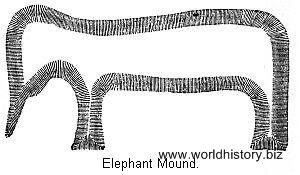
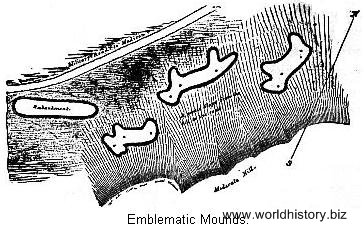
The manner in which they represented the various animals is full of interest to us. It has been discovered that they worked on a system. The last cut represents a group of three animals discovered a few miles from the Blue Mounds in Dane County. We notice at once a difference between the central animal, with a tail, and the other two. It will also be observed that the animals are represented in profile, with only two projections for legs. They are never separated so that we can distinguish the two front and the two hind feet. Animals so figured are the bear, fox, wolf, panther, and others. Grazing animals, such as the buffalo, elk, and deer, are represented with a projection for horns. In the last cut the other two animals are buffaloes. In various ways the particular kind of animal can nearly always be distinguished.45
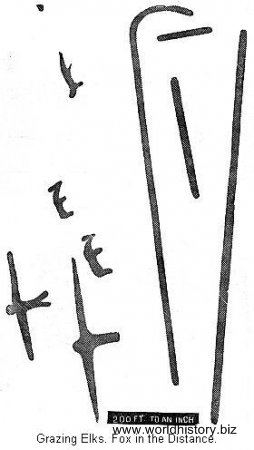
The preceding cut represents two elks grazing, and a fox in the distance. The long embankments of earth at one side are considered by Mr. Peet as in the nature of game drives. But we call attention to the expressiveness with which these figures are delineated. What could be more natural than the quietly grazing elks, with the suspicious prowling fox in the distance. In the cut we also see two cross-shaped figures. This was their method of representing birds, a projection on each side of a central body denoting wings. These figures are often very expressive.
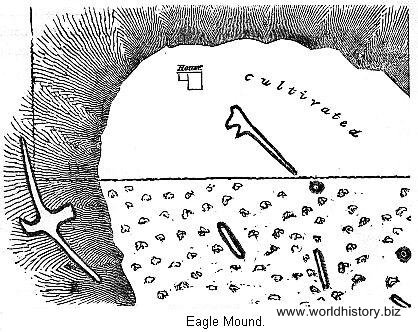
In this cut we have no difficulty in recognizing an eagle. It is represented as soaring high in the air. On the bluffs above it is a wolf effigy, and several conical and long mounds. In the cut preceding this the eagle and the hawk are hovering over the feeding elks, while in this cut a flock of hawks are watching some buffaloes feeding in the distance. This group of effigies was found on the banks of the Kickapoo River.
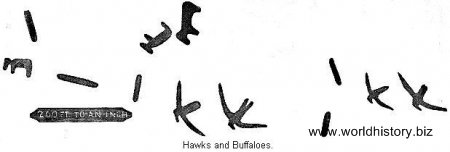
Our next cut represents a wild goose with a long neck and beak followed by a duck with a short neck, flying towards the lake.
Water-loving animals, such as salamanders and turtles, are represented in still another way, two projections on each side of a central figure. The next following cut represents a turtle. The tail was not always added. The salamander closely resembles the turtle, but notice the difference in the body, and still different is the cut of the musk-rat (see later). Fishes are figured as a straight embankment of earth tapering to a point.
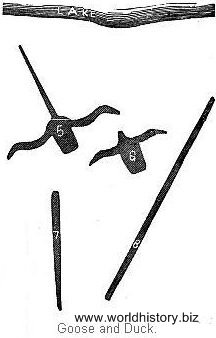
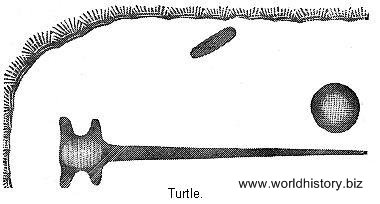
The same system that was observed in the location of signal mounds is to be noticed in the arrangements of these groups of effigy mounds. They are not alone. One group answers to another on a distant hill, or is in plain view of another group in the valley below. Distant groups were so related, each commanding a wide extent of country, and thus group answers to group, and mound to mound, for miles away, making a complete system throughout the region.
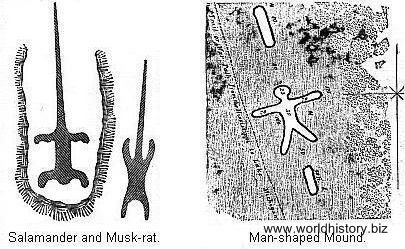
We notice this as to the location of the mounds. When we examine the mounds themselves we observe no little skill in the way they represent the animals. They often impressed on them something more than mere animal resemblances. "There are groups where the attitudes are expressive of a varied action. Certain animals, like the weasel or mink, being seen with a bird so near that, apparently, it might be caught by a single spring; and still others, like the wolf or wild-cat, are arranged head to head, as if prepared for combat; and still others, like the squirrel or coon, are in the more playful attitudes, sometimes apparently chasing one another over hill or valley; and again situated alone, as if they had just leaped from some tree, or drawn themselves out of some den or hole."46
Nor is the effigy of the human form wanting. It is found in several localities throughout the State. This cut shows us one such effigy. This was the beginning of a long train of animal mounds, presumably representing bears, found near the Blue Mounds, Wisconsin.47 We can not observe that any more importance was ascribed to the effigy of a human being than to that of an animal.
In casting about for suitable explanation for the erection of these animal mounds, we find ourselves lost in conjecture as to the motive which induced these people to prepare these earthen effigies. We may be sure that it was for some other reason than for amusement, or to give exercise to an artistic feeling. Only in very few instances do we detect any arrangements which would imply that they were in the nature of defenses. In some cases the effigies are so arranged as to form a sort of inclosure, some portion of the figure being prolonged to an unusual extent and thus inclosing a space that may have been utilized for a village site. This group on the Wisconsin River illustrates this point. Here the area thus partially inclosed, is about an acre. It is a singular fact that these inclosures are almost always triangular in shape.48 But it is manifest that a simple earth wall would serve for defense much better than these forms. They probably were not burial mounds, as few contain human remains, and it is not yet certain that these remains were not intrusive burials.49 It seems, therefore that they must have been in some manner connected with the religious life of the people.
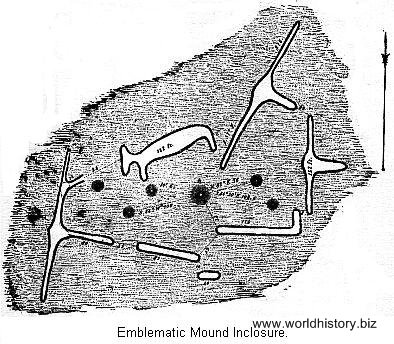
If we examine the various groups scattered throughout the State, this belief is strengthened. It is found, for instance, in nearly every group, that some one effigy is the principal one, and is placed in a commanding position, about which the other forms are arranged. It is also thought that the same effigy is the principal or ruling effigy over a wide district. In illustration of this, it can be stated that in the south-eastern part of the State the turtle is always the ruling effigy. In any group of effigies it is the principal one. It seems to watch over and protect the others. In subordination to it are such forms as the lizard, hawk, and pigeon. Passing to the North, the turtle is no longer the important figure. It is replaced by the wolf, or wild-cat. This is now the principal form, and if the turtle is sometimes present, it is of less importance.
So marked is the fact we have just stated that Mr. Peet says, "that sometimes this division assumes almost the character of a river system, and thus we might trace what seems to be the beginning in this country of that which prevailed on classic soil and in Oriental regions—namely, river gods and tutelar divinities of certain regions, each tribal divinity having its own province, over which it ruled and on which it left its own form or figure as the seal of its power and the emblem of its worship."50
Looking for some explanation of this, we may find a key in the known customs of various Indian tribes, and the lower races of men. It is known that a tribe of Indians is divided into smaller bands, which are called gens or clans. A gens may consist of several hundred persons, but it is the unit of organization. It takes the place of a family among civilized people. These various bands are generally named after some animal. In the beginning these names may have been of no special significance, but in course of time each band would come to regard themselves as descendants of the animal whose name they bore. Hence the animal itself would be considered sacred in their eyes, and its life would seldom be taken by members of that gens.
The animal thus honored by the gens was, in the Indian dialect, the totem of the clan. This organization and custom we find running all through the Indian tribes. In many tribes the Indians were wont to carve a figure of their totem on a piece of slate, or even to carve a stone in the shape of the totem, which carved or sculptured stone they wore as an ornament, or carried as a charm to ward off evil and bring them good luck.51 We need only suppose that this system was very fully developed among the Mound Builders of Wisconsin, to see what important bearing it has on these effigy mounds.
NEXT Link
PAST of our race is irradiated here and there by the light of science sufficiently to enable us to form quite vivid conceptions of vanished peoples. As the naturalist, from the inspection of a single bone, is enabled to determine the animal from which it was derived, though there be no longer a living representative, so the archæologist, by the aid of fragmentary remains, is able to tell us of manners and times now long since removed. In the words of another: "The scientist to-day passes up and down the valleys, and among the relics and bones of vanished people, and as he touches them with the magic wand of scientific induction, these ancient men stand upon their feet, revivified, rehabilitated, and proclaim with solemn voice the story of their nameless tribe or race, the contemporaneous animals, and physical appearance of the earth during those prehistoric ages."2
We have already learned that the world is full of mysteries, and though, by the exertion of scholars, we begin to have a clearer idea of some topics, yet our information is after all but vague and shadowy. The amount of positive knowledge in regard to the mysterious tribes of the older Stone Age, or the barbarians of the Neolithic period, or the struggling civilization of the early Metallic Ages, is lamentably deficient. On our Western Continent we have the mysterious remains in the gold-bearing gravels of the Pacific coast, the significance of which is yet in dispute. We have the Paleolithic Age of Europe, represented by the remains found in the gravels of the Delaware at Trenton, New Jersey. When deposited there, and by what people used, is, perhaps, still enshrouded in doubt.
Leaving now the past, expressed by geological terms, or by periods of thousands of years, we draw near to our own tribes, near, at least, comparatively speaking, and behold, here, also, we discern evidence that an ancient culture, as marked as that which built its cities along the fertile water-courses of the Old World, had its seat on the banks of our great rivers; that here flourished in full vigor for an unknown length of time a people whose origin and fate are yet in doubt, though, thanks to the combined efforts of many able men, we begin to have clearer ideas of their social organization. We know them only by reason of their remains, and as these principally are mounds, we call them the "Mound Builders."
The name is not a distinguishing one in every sense, since mankind, the world over, have been mound and pyramid builders. The pyramids of Egypt and the mound-dotted surface of Europe and Asia bear testimony to this saying, yet nowhere else in the world are they more plainly divided into classes, or marked with design than here. In some places fortified hills and eminences suggest the citadel of a tribe or people. Again, embankments of earth, mostly circular or square, separate and in combination, generally inclosing one or more mounds, excite our curiosity, but fail to satisfy it. Are these fading embankments the boundaries of sacred inclosures, or the fortification of a camp, or the foundations on which to build communal houses? Here graded ways, there parallel embankments raise questions, but suggest no positive answer. We are equally in doubt as to the purposes for which many of the mounds were built. Some seem to have been used as places of sepulcher, some for religious rites, and others as foundation site of buildings. Some may have been used as signal mounds, from which warning columns of smoke, or flaming fires, gave notice of an enemy's approach.
Before coming to details let us, at a glance, examine the picture as a whole. This country of ours, with its wide plains, its flowing rivers and great lakes, is said by scholars to have been the home of a people well advanced in the arts of barbarian life. What connection, if any, existed between them and the Indians, is yet unsettled. We are certain that many years before the Spanish discovery of America they made their settlements here, developed their religious ideas, and erected their singular monuments. That they were not unacquainted with war, is shown by their numerous fortified inclosures. They possessed the elements of agriculture, and we doubt not were happy and contented in their homes. We are certain they held possession of the fairer portions of this country for many years.
We must now seek to gather more particular knowledge of them, and of the remains of their industry. We must not forget that these are the antiquities of our own country; that the broken archæological fragments we pick up will, when put together, give us a knowledge of tribes that lived here when civilization was struggling into being in the East. It should be to us far more interesting than the history of the land of the Pharaohs, or of storied Greece. Yet, strange to say, the facts we have just mentioned are unknown to the mass of our people. Accustomed to regard this as the New World, they have turned their attention to Europe and the East when they would learn of prehistoric times. In a general way, we have regarded the Indians as a late arrival from Asia, and cared but little for their early history. It is only recently that we have become convinced of an extended, past in the history of this country, and it is only of late that able writers have brought to our attention the wonders of an ancient culture, and shown us the footprints of a vanished people.
We must first try and locate the territory occupied by the remains of the mound builders. They are not to be found broadcast over the whole country. We recall, in this connection, that the early civilization of the East arose in fertile river valleys. This is found to be everywhere the case, so we are not surprised to learn that the broad and fertile valley of the Mississippi, with its numerous tributaries, was the territory where these mysterious people reared their monuments and developed their barbarian culture. Throughout the greater portion of this area we find numerous evidences of a prolonged occupation of the country. We are amazed at the number and magnitude of the remains. Though this section has been under cultivation for many years, and the plow has been remorselessly driven over the ancient embankments, yet enough remain to excite our curiosity and to amply repay investigation.
This portion of the United States seems to have been the home, the seat of the mound building tribes. We can not expect to find one type of remains scattered over this entire section of country. Indeed, to judge from the difference of the remains, they must have been the work of different people or tribes, who were doubtless possessed of different degrees of culture.3 We will notice in our examination how these remains vary in different sections of the country. But it is noticeable that these remains become scarce and finally disappear as we go north, east, and west from the great valley. Although they are numerous in the Gulf States, yet they are not to be found, except in a few cases, in States bordering on the Atlantic.4 Some wandering bands, perhaps colonies from the main body of the people, established works on the Wateree River, in South Carolina,5 In the mountainous regions of North Carolina occur mines of mica, which article was much prized by the mound builders; and here also are to be found traces of their early presence.6 We do not know of any authentic remains in New England States. In Western New York there exists a class of remains which, though once supposed to be the work of these people, are now generally considered as the remains of works erected by the Indians,7 and of a similar origin appears to have been the singular fortification near Lake Winnipiseogee, in New Hampshire.8
We have no record of their presence north of the great lakes. Passing now to the western part of the valley, we do not find definite traces of their presence in Texas. On this point, however, some authors state the contrary, apparently basing their views on a class of mounds mentioned by Prof. Forshey.9 But the very description given of these mounds, and the statements as to the immense number of them,10 seem to show they are not the work of men.11 We do not think the West, and especially the North-west, has been carefully enough explored to state where they begin. It is certain that the head waters of the Mississippi and the Missouri were thickly settled with tribes of this people, and some writers think that they spread over the country by way of the Missouri Valley from the North-west. Mr. Bancroft quotes from the writings of Mr. Dean, to show the existence of mounds and inclosures on Vancouver Island, and in British Columbia. And the statement is made that a hundred miles north of Victoria there is a group of mounds ranging from five to fifty yards in circumference, and from a few feet to fifty feet in height.12
The inclosures, however, are described as being very similar to those in Western New York, and are probably simply fortified sites, common among rude people the world over, and such as were often erected by Indians. The remains on the upper Missouri and its tributaries are very numerous, and to judge from the brief description given us of them, they must be very interesting.13 This section has, however, been too little explored to speak with confidence of these works.
As showing how much care should be exercised in this matter, we refer to the account given by Capt. Wilkes in his journal of the United States exploring expedition. Speaking of the mounds on the gravelly plains between the Columbia River and Puget Sound, he tells us that the Butte Prairies are covered with small mounds at regular distances asunder. Some of them are thirty feet in diameter, six or seven feet above the level of the ground, and many thousands in number. He opened some of them, and found a pavement of round stones, and he thought he could detect an arrangement of the mounds in groups of five, thus.
It was his impression that they were the works of men, and had been constructed successively and at intervals of several years.14 This observation of Capt. Wilkes is referred to by many as evidence of the former existence of Mound Builders in this section.
More careful research in recent times has established the fact that these mounds were certainly not erected by human hands, and no one else has been able to discover the supposed arrangement in groups of five. The pavement of round stones is common to the whole prairie.
But the greatest objection is the number of the mounds. A population larger than could have found a living in the country must have been required to erect them, unless we assume that a great length of time was consumed in this work. Some other explanation must be given for these mounds, as well as for those mysterious ones mentioned by Prof. Forshey. This cut gives us a fair idea of the scenery of this section and the mounds.15

Within the area we have thus defined are located the works of the people we call the Mound Builders. What we wish to do is to learn all about these vanished people. A great many scholars have written about them, and large collections of the remains of their handiwork have been made. There is, however, a great diversity of opinion respecting the Mound Builders and their culture. So we see we have a difficult subject to treat of. In order to gain a clear understanding of it, we must describe the remains more closely. About all we can learn of these people is from a study of their monuments. We can not call to our aid history or tradition, or rock-carved inscription, but must resort to crumbling mounds, broken down embankments; study their location, and observe their forms. To the studies in the field we must add those in the cabinet, and examine the many objects found in and above the mounds and earth-works, as well as the skeletons of the builders of the works. Rightly used, we can draw from these sources much valuable information of the people whose council-fires blazed all along the beautiful valleys of the Ohio and Mississippi rivers in times far removed from us.

We will first speak of the simplest form of these works, the ordinary conical mound. This is the one form found all over the extensive area designated. They exist in great numbers on the banks of the upper Missouri, as well as the river bottoms of the South. This cut represents a very fine specimen of a mound, in this instance surrounded by a circular embankment. We must not forget that mounds are found all over the world. "They are scattered over India, they dot the steppes of Siberia and the vast region north of the Black Sea; they line the shores of the Bosphorus and the Mediterranean; they are found in old Scandinavia, and are singularly numerous in the British Islands."16
The principle in human nature which leads to the erection of mounds is living and active to-day. The shaft which surmounts Bunker Hill is but a modern way of memorizing an event which in earlier ages would have led to the erection of a mound, and the polished monument which marks the resting place of some distinguished man was raised for the same purpose as the mounds heaped over the chiefs and warriors of another age. The feeling which moves us to crown with steeples or spires our houses of worship is evidently akin to that which induced older races to erect a mound on which to place their temples, their idols, and altars of sacrifice.
If mounds were the only works remaining of these ancient people, we would not take so great an interest in them, and, as it is, we are not to suppose that all the mounds are the works of those people we call the Mound Builders. Recent investigation and historical evidence unite in showing that some comparatively recent Indian tribes formed and used mound structures. Early explorers have left abundant testimony to show that in many cases the Indians resorted to mound-burial. Thus, it seems that it was the custom of the Iroquois every eighth or tenth year, or whenever about to abandon a locality, to gather together the bones of their dead and rear over them a mound. To this custom, which was not confined to the Iroquois, are doubtless to be ascribed the barrows and bone mounds which have been found in such numbers in various parts of the country.17 Although it is well to bear these facts in mind, yet it is not doubted that the larger number, and especially the more massive ones, were erected by the same people who built the other mysterious works, and so it is necessary that they be carefully studied.

In the valley of the Ohio there have been found a class of mounds known as Altar Mounds. These, it should be stated, nearly always occur in or near inclosures. This cut gives us a good idea of mounds of this kind. Near the top is seen an instance of what is called "intrusive" burial. After the mound was completed it had been dug into and a body buried near the surface. This burial was evidently later in time, and had no connection with the purpose for which the mound was originally built. We also notice in this mound the different layers of which it was composed. These layers are of gravel, earth, and sand, the latter being only a few inches thick. Mounds made in this manner are called stratified mounds, and all altar mounds are probably of this kind. The lines of stratification have been described as curving so as to correspond with the shape of the mound, and such we are told is the general rule.18
The peculiar feature, however, is the altar at the bottom of the mound, directly above the natural surface of the ground. The small cut gives us a clear idea of the altar, the light lines running around it showing the plan. These altars are almost always composed of clay, though some of stone have been discovered. They are of various shapes and sizes. We notice the dish-shaped depression on the top of the altar. The clay of which they are composed seems to have been moulded into shape directly over the surface of the ground. Sometimes a layer of sand was put down as a foundation. They are nearly always thoroughly burned, the clay being baked hard, sometimes to the depth of fifteen or twenty inches. This must have required intense and long continued heat.
We are at once curious to know the object of this altar. Within the basin-shaped depression are generally found all manner of remains. Sometimes portions of bones, or fragments of wood, arranged in regular order; pieces of pottery vessels, and implements of copper and stone; spear-heads, arrow-heads, and fragments of quartz and crystals of garnet. Pipes are a common find, carved in miniature figures of animals, birds, and reptiles. Two altar-mounds but recently examined near Cincinnati had altars about four feet square that were loaded down with ornaments.
One especially contained quantities of ornaments of stone, copper, mica, shells, the canine-teeth of bears and other animals, and thousands of pearls. They were nearly all perforated, as if for suspension. Several of the copper ornaments were covered with native silver which had been hammered out into thin sheets and folded over the copper. One small copper pendant seems to have been covered with a thin sheet of hammered gold, as a small piece was still clinging to it. This is the first example of finding native gold in the mounds.19 On this altar were also found masses of meteoric iron, and ornaments of the same material. One piece of mica showed the profile of a face.20
In all cases the articles found on the altars show the action of fire. We seem justified, then, in supposing that after the altar was formed, fires were lit on them, and into this fire were thrown the various articles just enumerated. But what was all this for? This will probably never be very clear to us, beyond the fact that it was a religious rite. Portions of the human skeleton have been found on these altars, and it has been suggested that human victims were at times part of the sacrifice; but as it is known that this people practised cremation, it may be that the altars were sometimes used for that purpose, the remains being afterwards gathered and buried elsewhere.
After the offerings had been flung into the fire, while it was yet glowing on the altar, earth or sand was heaped over them for a few inches, then successive layers of earth and sand, or ashes, clay, or gravel. Sometimes the altars were used several different times, in which case a layer of clay several inches thick was laid over the old altar. In one case three layers had been burned in before the final addition of earth and sand were heaped over it. These strange monuments of a by-gone people hint to us of mysterious rites. We wish we had more positive knowledge of the ceremonies they commemorated; but at present we must rest satisfied with conjecture.
The next class of mounds are known as burial mounds, some of which are stratified, and resemble the so-called altar mounds. A mound explored in Butler County, Ohio, had in the center a layer of clay an inch thick, which had been burned until it was red. Underneath this was another layer of clay, beneath which was found charcoal, burnt cloth, and charred bones. Mr. Foster thinks that in this mound the body was placed on a rude altar, fires were lit, and that while yet burning, clay was thrown over it all, and that then fires were built all over the mound, sufficient to burn the clay for an inch in thickness.21 We have also a description of a group of mounds explored near the Mississippi River, in which there were evident signs of cremation. At least in several mounds fires had been built close above the bodies. But in cremation other victims may have been burned to accompany the departed chiefs or warriors. In one mound evidence of such a custom was observed.
In another mound the center was found to be a mass of burned clay interspersed with calcined human bones. No less than ten or fifteen bodies had been burned here. "They must have worshiped some fierce ideal deity, and the ceremony must have been considered of great importance to have required so many victims." This may have been, however, nothing more than simple cremation.22
Pidgeon has described mounds in Minnesota, in many respects like the altar mounds. In one case he mentions there was an altar or pavement of stone on the original surface of the ground, a few feet above which was a layer of clay, showing the action of fierce and long-continued fires. We furthermore are told that cremation, especially of chiefs, was more or less common among the Village Indians of North America, that similar usage was observed among many of the tribes of Mexico, and that the Mayas, of Yucatan, burnt the bodies of their lords, and built temples over their remains. So it may be that the altar mounds are but varieties of funeral mounds, the remains of the bodies burned here being buried elsewhere.23

The nations that celebrated their mysteries around these mounds have long since departed; the altar fires long since burned low. We are not sure that we understand their purport, but we are certain they were regarded as of great importance, and we can readily imagine that when the fires were lit on the altars, gathering crowds stood round, and participated in the religious observance, throwing into the fire their most valued ornaments, in this manner paying their last respects to the departed chiefs and great men of their tribe.
The true burial mounds are very numerous, an comprise by far the larger number of mounds. They are to be found all over the Mound Builders' territory, and are about the only class of remains found in the prairie regions of the West. From the upper waters of the Missouri and the great lakes on the north to the Gulf States on the south, and from west of the Mississippi to the Alleghenies of the East, in all this vast region they are the prevailing class of remains, and occur by hundreds, and even thousands, along the valleys. The mounds themselves are often not very conspicuous; as a rule they are simply heaps of dirt raised above the surface and rounded over, and from two or three to fifteen or twenty feet high, although many are of much larger size. They are seldom found on the lower, or recent river terrace, but are common on the upper terrace, and are often built upon the high bluffs bordering the streams, where a wide stretch of country is exposed to view. Black-bird, an Omaha chief, who died about the year 1800, desired to be buried on a high bluff overlooking the Missouri, so that he might see the boats passing up and down the river. Perhaps from a similar superstitious wish the Mound Builders sometimes chose the sites of their burial mounds where they could watch over their country; or it may be that the monuments over the dead were placed in such conspicuous positions that they might be readily seen by the people.
The next cut represents an ordinary burial mound, which was explored by tunneling in from one side. We notice there are no different layers or stratifications in this case. In some cases, at least, the building of such a mound occupied several years. We can see where the dirt was thrown down in small quantities, averaging about a peck, as if from a basket. In one case grass had started to grow on the unfinished surface of the mound, to be covered up by fresh dirt.24

In the majority of cases the mounds contain the remains of but one individual, with various relics of a rude and barbarous people. Where but one body was buried, the usual mode of procedure seems to have been to first clear a space on the surface of the ground; the body was then placed in the center of this prepared place, and often a rude framework of timber was placed around it, sometimes a stone chamber was built up. Over this the mound was erected to the desired height. This description would apply to nearly all of the many thousands of burial mounds in the country.
In the cut a layer of charcoal is noticed near the top. Nearly all mounds show evidence of the existence of fire during some period of their construction. In some cases these fires were fierce and long continued, as if the object had been to cremate the body. It may have been a part of their religious belief that it was necessary to keep fires blazing on the mound for a short length of time to keep off evil spirits, or to comfort the soul of the departed. Such at any rate was the custom among some Indian tribes. We are told that among the Iroquois, a "fire was built upon the grave at night to enable the spirit to prepare its food."25
In some cases, many individuals were buried in the same mound. These may be communal burials, such as we have already referred to. Mounds of this kind have been examined near Nashville, Tennessee. One mound alone was the burial place of over two hundred persons. Pidgeon describes some triangular burial mounds in Minnesota, differing in shape only from the ordinary circular mounds that belong to this division. In general, burial mounds are not very high, yet there are exceptions to this rule.

This cut represents one of the largest of these mounds. It is situated at the junction of Grave Creek and the Ohio River, twelve miles below Wheeling, in West Virginia. It measures seventy feet in height, and its base is nearly one thousand feet in circumference. An excavation made from the top downward, and from one side of the base to the center, disclosed the fact that the mound contained two sepulchral chambers, one at the base and one near the center of the mound. These chambers had been constructed of logs, and covered with stone. The lower chamber contained two skeletons, one of which is supposed to have been a female. The upper chamber contained but one skeleton. In addition to these, there were found a great number of shell beads, ornaments of mica, and bracelets of copper.26
A moment's thought will show us what a great work such a mound must have been for a people destitute of metallic tools and domestic animals. The earth for its construction was probably scraped up from the surface and brought thither in baskets. A people capable of erecting such a monument as this, with only such scanty means at their command, must have possessed those qualities which would sooner or later have brought them civilization.
Another very interesting mound of this class once stood in the city of St. Louis. The rapidly growing city demanded its removal in 1869. It was an oblong mound, one hundred and fifty feet long by thirty in height. In its removal it was shown that it contained a burial chamber seventy-five feet long, from eight to twelve feet wide, and from eight to ten feet high, in which about thirty burials had taken place. The surface of the ground had first been leveled, then the walls raised to the desired height, made firm and solid, and plastered with clay. Timbers formed the roof, over which the mound had been raised to the desired height.

In process of time the roof decayed and fell in, thus giving a sunken appearance to the top of the mound. This view is a cross section of the mound as it was revealed by the workmen. We notice where the roof has fallen in, and the outline of the interior chamber. This burial chamber was perhaps an exact model of the cabins in which the people lived. Can it be that this mound was the final resting place of some renowned chief, and that the other bodies were those of his attendants sent to accompany him to the other world? This is perhaps as reasonable a conjecture as any. Certain it is that this tumulus and that at Grave Creek were fit pyramids for the Pharaohs of the New World.
It is not to be supposed that the mounds were the sole cemeteries of the people who built them. Like the barrows of Europe, they were probably erected only over the bodies of the chiefs and priests, the wise men, and warriors of the tribe. The amount of work required for the erection of a mound was too great to provide one for every person. The greater number of the dead were deposited elsewhere than in mounds, but it is doubtful whether we can always distinguish the prehistoric burial places from those of the later Indians. An ancient cemetery, discovered near Madisonville, Ohio, proved to be a most interesting find, as it was thought to be a burial place of the Mound Builders,27 but it seems there is strong doubt on this point. One writer thinks this was a cemetery of the Erie tribe of Indians, and not very ancient in date.28
In Tennessee are to be found numerous burial places known as the stone-grave cemeteries. Stone graves of a similar character are found in Kentucky, Ohio, and Missouri. These are as yet but few facts which can be used as indicating that all the stone graves are of one people. Many of these cemeteries are of great antiquity, while similar stone graves are of quite recent date. In some places the cemeteries cover very large areas.

We have now to describe a class of mounds that are always regarded with great interest, as a number of our scholars think they see in them the connecting link between the remains in this country and those of Mexico and the South. These are generally known as "temple mounds," from the common impression that they were sites of temples or public buildings. In general terms, mounds of this class are distinguished by their large size and regularity of form, and they always have a flat or level top. On one side there is generally a graded way leading up to the summit, in some instances several such methods of approach. Sometimes the sides of the mound are terraced off into separate stages.29
We have already noticed that different sections of country are distinguished by different classes of mound remains. In the present State of Ohio are found many altar mounds and inclosures. In the West are large numbers of burial mounds, but the so-called temple mounds are most numerous in the South. At one place in Wisconsin is found a low embankment inclosing four low mounds with leveled tops. But the resemblance between these and the regular temple mounds is certainly slight. Only a few instances of these flat-topped mounds are found in Ohio. Of these the still existing "elevated squares" at Marietta are good examples.

This cut represents the mound preserved in the park at Marietta. It is ten feet high, one hundred and eighty-eight feet long, by one hundred and thirty-two feet wide. The platform on the top has an area of about half an acre. Graded ways lead up on each of the four sides. These grades are twenty-five feet wide, and sixty feet long.30
As we approach the Gulf States, these platform mounds increase in number. The best representative of this class, the most stupendous example of mound builders' work in this country, is situated in Illinois, not far from St. Louis. The mound and its surroundings are so interesting that they deserve special mention. One of the most fertile sections of Illinois is that extending along the Mississippi from the Kaskaskia to the Cahokia river, about eighty miles in length, and five in breadth. Well watered, and not often overflowed by the Mississippi, it is such a fertile and valuable tract that it has received the name of the "Great American Bottom." It is well known that the Mound Builders chose the most fertile spots for their settlements, and it is therefore not surprising to find the evidence that this was a thickly settled portion of their territory. Mr. Breckenridge, writing in 1811, says: "The great number of mounds, and the astonishing quantity of human bones, everywhere dug up or found on the surface of the ground, with a thousand other appearances, announces that this valley was at one time filled with habitations and villages. The whole face of the bluff, or hill, which bounds it on the east, appears to have been a continuous burying ground."31
Mounds are numerous in this section. We learn that there are two groups of mounds or pyramids, one about ten miles above the Cahokia, and the other about the same distance below it, more than one hundred and fifty in all. Speaking of the group above the Cahokia, Mr. Breckenridge says: "I found myself in the midst of a group of mounds mostly of a circular shape, and, at a distance, resembling enormous hay-stacks scattered through a meadow. One of the largest which I ascended was about two hundred paces in circumference at the bottom, the form nearly square, though it had evidently undergone considerable alteration from the washing of rains. The top was level, with an area sufficient to contain several hundred men." He represents the view from the top of the mound to be a very extensive and beautiful one. From this elevation he counted forty-five mounds or pyramids, besides a great number of small artificial elevations. This group was arranged in the form of a semicircle, about a mile in extent, the open space being on the river.

Three miles above occurs the group in which is found the famous big mound.32 This cut gives us a good idea of the mound as it was in its perfect state. All accounts given of this mound vary. From a cut of the model, as prepared by Dr. Patrick, the area of the base is a trifle over fifteen acres.33 The ascent was probably on the south side of the mound, where the little projection is seen. The first platform is reached at the height of about fifty feet. This platform has an area of not far from two and four-fifth acres. Large enough for quite a number of houses, if such was the purpose for which this mound was erected. The second platform is reached at about the height of seventy-five feet, and contains about one and three-fourth acres. The third platform is elevated ninety-six or ninety-seven feet, while the last one is not far from one hundred feet above the plain. The area of the last two is about three-fourths of an acre each. The areas of all the platforms are not far from six acres. We require to dwell on these facts a moment before we realize what a stupendous piece of work this is. The base is larger than that of the Great Pyramid,34 and we must not lose sight of the fact that the earth for its construction was scraped up and brought thither without the aid of metallic tools or beasts of burden, and yet the earth was obtained somewhere and piled up over an area of fifteen acres in one place to a height of one hundred feet, and even the lowest platform is fifty feet above the plain. Some have suggested that it might be partly a natural elevation. There seems to be, however, no good reason for such suggestions.
What motive induced the people to expend so much labor on this mound? It is not probable that this was a burial mound, though it may ultimately prove to be so. The most probable supposition is that the mound was erected so as to secure an elevated site, perhaps for purpose of defense, as on these platforms there was abundant room for a large village, and an elevation or height has always been an important factor in defenses. In this connection, Prof. Putnam has called our attention to a fact which indicates that a very long time was occupied in the construction of the mound, and further, that a numerous population had utilized its platforms as house sites—that is, that "everywhere in the gullies, and over the broken surface of the mounds, mixed with the earth of which it is composed, are quantities of broken vessels of clay, flint chips, arrow-heads, charcoal, bones of animals, etc., apparently the refuse of a numerous people." The majority of writers, however, think that this elevated site, obtained as the result of so much labor, was utilized for important public buildings, presumedly the temple of their gods, and no one can help noticing the similarity between this structure and those raised by the ancient Mexicans for both religious purposes and town sites.
Mr. Foster thinks that "upon this platform was reared a capacious temple, within whose walls the high-priests gathered from different quarters at stated seasons, celebrated their mystic rites, while the swarming multitudes below looked up with mute adoration."35 Mr. Breckenridge, whose writings we have already referred to, at the time of his first visit, "everywhere observed a great number of small elevations of earth, to the height of a few feet, at regular distances apart, which appeared to observe some order: near them pieces of flint and fragments of earthen vessels." From this he concludes that here was a populous town, and that this mound was a temple site. It is doubtful whether we shall ever pierce the veil that lies between us and this aboriginal structure. The pyramids of the Old World have yielded up their secret, and we behold in them the tombs of Egypt's kings. But this earthen pyramid on the western prairie is more involved in mystery, and we do not know even its builders. If the result of religious zeal, we may be sure that a religion which exacted from its votaries the erection of such a stupendous piece of work was one of great power.
As before remarked, "temple mounds" increase in numbers and importance as we go south. In Kentucky they are more frequent than in the States north of the Ohio River, and in Tennessee and Mississippi they are still more abundant.36 We also learn that they are often surrounded, or nearly so, with moats or ditches, as if to fortify their location. Our next cut illustrates such an arrangement—a circular wall of earth four feet high and two thousand three hundred feet in circumference, incloses four mounds, two of which are temple mounds. According to the late Prof. Forshey, temple mounds abound in Louisiana. He described a group situated in Catahoola County, in which the principal mound has a base of more than an acre, a height of forty-two feet, and the upper platform an area of nearly one-third of an acre. The smaller mounds are arranged around this larger one. This group is defended by an embankment. From this point for a distance of twenty miles along the river, are scattered similar groups of mounds; in all cases the smaller ones arranged around the larger one, which is presumably the site of a temple.

A digression right here may not be devoid of interest. We are not sure but that the dim, uncertain light of history falls on the origin of this group of mounds. When the French first commenced their settlement in the lower Mississippi Valley, the Natchez Indians was the most powerful tribe in all that section. In the course of time, wars ensued between them and the French, and in the year 1730 they fled into Upper Louisiana, and settled at the place where these mounds are now found. But the French followed them a year or so afterwards, and nearly exterminated. them. Some of our scholars think that they erected these mounds.37 The historian of that epoch simply says they had "built a fort there." It is however questioned whether they had time to build works of such magnitude. But they were both a mound-building and a mound-using people, and we are not prepared to say how long it would take them to do the work, until we know the number engaged, methods employed, and other considerations.38 If they did not build these works, they doubtless cleared them of trees and utilized them; and this place was therefore the scene of the final downfall of the Natchez—a people we have every reason to regard as intimately connected with the prehistoric mound-building tribes.
The largest temple mound in the South is near Seltzertown, Mississippi. Its base covers about six acres, and it rises forty feet. This slope was ascended by means of a graded way. The summit platform has an extent of nearly four acres. On this platform three other mounds had been reared—one at each end, and a third in the center. Recent investigation by the Bureau of Ethnology have shown that the base of this mound is a natural formation. Lumps of sun-dried, or partially burnt clay, used as plastering on the houses of the Mound Builders, gave rise to a sensational account of a wall of sun-dried bricks two feet thick, supporting the mound on the northern side.39 The famous Messier Mound, in Georgia, is said to reach a height of ninety-five feet. But a large part of this elevation is a natural eminence; the artificial part is only a little over fifty feet.

A work of unusual interest occurs on the Etowah River, Georgia. This cut gives us a plan of the work. We notice, first of all, the moat or ditch by which they fortified their position. The ditch is still from five to twenty-five feet deep, and from twenty to seventy-five feet wide. It connects directly with the river at one end, but stops short at the other. It surrounds nearly fifty acres of land. At two points we notice reservoirs, each about an acre in size, and an average depth of not less than twenty feet. At its upper end is an artificial pond. This ditch, with its reservoirs and pond, is no slight work. The large mound seen in the center of the space is one of the largest of the temple mounds. Its shape is sufficiently shown in the cut. The height of the mound is sixty-five feet. We call especial attention to the series of terraces leading up the south side of the mound. Graded ways afford means of access from one terrace to the other. A pathway is also seen on the eastern side.
To this group of works an interest attaches similar to that of the group of works mentioned in Louisiana. We are not certain but that we catch a glimpse of it while it was yet an inhabited Indian town. This is contained in the brief accounts we have of the wanderings of the unfortunate De Soto and his command. One of the chroniclers of this expedition La Vega, describes one of the towns where the weary Spaniards rested, and which we are sure was somewhere in Northern Georgia, in such terms, mentioning the graded way leading to the top, that Prof. Thomas, who has spent some time in this investigation, thinks his description can apply only to the mound under consideration.40 Whether this conclusion will be allowed to stand, remains to be seen. But, if true, then the darkness which rests upon this aboriginal structure lifts for a moment and we see around it a populous Indian town, able to send five hundred warriors to battle. The Spaniards marched on to sufferings and death, and darkness again closed around the Etowah Mound. When the Europeans next beheld it around it was the silent wilderness; the warriors had departed; the trees of the forest overspread it.
We have now described the principal mound structures, and shown the different classes into which they are divided. But a large class of mounds are found scattered all through the Mound Builders' territory that were probably used as signal mounds. Burial mounds were also often used for this purpose.41 This was because their location was always very favorable for signal purposes. Signaling by fire is a very ancient custom. The Indians on our western plains convey intelligence by this means at the present day. Some tribes use such materials as will cause different shades of smoke, using dried grass for the lightest, pine leaves for the darkest, and a mixture for intermediate purposes. They also vary the signal by letting the smoke rise in an unbroken column, or cover the fire with a blanket, so as to cause puffs of smoke. The evidence gathered from the position of the mounds, and traces of fire on their summit, is that the Mound Builders had a very extensive system of signal mounds.

To illustrate this system, we would state that the city of Newark, Ohio, was the site of a very extensive settlement of the Mound Builders. This settlement was in a valley, but on all the surrounding hills were located signal mounds. And it is further stated that lines of signal mounds can be traced from here as a center to other and more distant points. The large mound at Mt. Vernon, twenty miles to the north, was part of this system. As the settlements of the Mound Builders were mostly in river valleys, we would expect to find all along on the bluffs fronting these valleys traces of signal mounds. In the Scioto Valley, from Columbus to Chillicothe, a distance of about forty miles, twenty mounds "may be selected, so placed in respect to each other that it is believed, if the country was cleared of forests, signals of fire might be transmitted in a few minutes along the whole line." Some think the chain is much more extensive than this, and that the whole Scioto Valley, from Delaware County to Portsmouth, was so provided with mounds that signals could be sent in a very few minutes the whole distance.42

The valley of the Miami River was equally well provided with signal mounds. This great mound, at Miamisburg, Ohio, rising to the height of sixty-eight feet, was one of the chain by which signals were transmitted along the valley. Not only was each river valley thus provided, but there is evidence that communication was established between different river systems, so we can easily see how quickly the invasion of their country by an enemy from any quarter would become known in widely scattered sections. Immediately across the river from Chillicothe, Ohio, on a hill nearly six hundred feet high, was located a signal mound. A fire built upon it would be visible twenty miles up the valley, and an equal distance down. It would be also visible far down the valley of Paint Creek. Some think that such a system of lofty observatories extended across the whole State of Ohio, of Indiana, and Illinois, the Grave Creek mound, on the east, the great mound at Cahokia, on the west, and the works in Ohio filling up the line. We do not believe, however, it is safe to draw such conclusions. It is doubtful whether there was any very close connection between the tribes in these several sections.
In the State of Wisconsin are found some of the most interesting remains of the Mound Builders. They are so different from the ordinary remains found elsewhere that we must admit that the people who built them differed greatly from the tribes who built the great temple mounds of the South, or the earthworks of Ohio. The remains in Wisconsin are distinguished not by their great size or height, but by their singular forms. Here the mound building instincts of the people were expressed by heaping up the earth in the shape of animals. What strange fancy it was that led them to mould the figures on the bluffy banks of the rivers and the high lands about the lakes of their country, we shall perhaps never know. That they had some design in this matter is, of course, evident, and if we would try and learn their secret, we must address ourselves to a study of the remains.

Effigy mounds are almost exclusively confined to the State of Wisconsin. We, indeed, find effigy mounds in other sections, but they are of rare occurrence.43 They, however, show that the same reasons, religious, or otherwise, exists in other localities, while in the area covered by the southern portion of the State of Wisconsin it found its greatest expression. This cut affords us a fair idea of effigy mounds. Here are seen two animals, one behind the other. On paper we can readily see the resemblance. Stretched out on the ground, and of gigantic proportions, the resemblance is not so marked, and some might fail to notice it at first sight. Either of those figures is over one hundred feet long, and about fifteen feet wide. With few exceptions, effigy mounds are inconsiderable in height, varying from one to four feet. These mounds have been carefully studied of late years, and there is no doubt that in many instances we can distinguish the animals represented.
We learn, then, that tribes formerly living in Wisconsin had the custom of heaping up the earth in the shape of the various animals peculiar to that section. But no effigies are found of animals that have since become extinct, or of animals that are to be found only in other lands.
Our next cut represents the famous elephant mound of Wisconsin, on the strength of which a number of fair theories have been given relating to the knowledge of the mastodon by the builders of the mound, and its consequent antiquity. It now bears some resemblance to an elephant, but we learn that the trunk was probably produced by the washing of the banks and, from the same cause, a projection above the head, supposed to represent horns, has disappeared. Taking these facts into consideration, it is quite as likely that it represented a buffalo.44 One writer even thinks he found a representation of a camel, but the fact is, the more these effigy mounds are studied, the more certain are we that they are representations of animals formerly common in that region.


The manner in which they represented the various animals is full of interest to us. It has been discovered that they worked on a system. The last cut represents a group of three animals discovered a few miles from the Blue Mounds in Dane County. We notice at once a difference between the central animal, with a tail, and the other two. It will also be observed that the animals are represented in profile, with only two projections for legs. They are never separated so that we can distinguish the two front and the two hind feet. Animals so figured are the bear, fox, wolf, panther, and others. Grazing animals, such as the buffalo, elk, and deer, are represented with a projection for horns. In the last cut the other two animals are buffaloes. In various ways the particular kind of animal can nearly always be distinguished.45

The preceding cut represents two elks grazing, and a fox in the distance. The long embankments of earth at one side are considered by Mr. Peet as in the nature of game drives. But we call attention to the expressiveness with which these figures are delineated. What could be more natural than the quietly grazing elks, with the suspicious prowling fox in the distance. In the cut we also see two cross-shaped figures. This was their method of representing birds, a projection on each side of a central body denoting wings. These figures are often very expressive.

In this cut we have no difficulty in recognizing an eagle. It is represented as soaring high in the air. On the bluffs above it is a wolf effigy, and several conical and long mounds. In the cut preceding this the eagle and the hawk are hovering over the feeding elks, while in this cut a flock of hawks are watching some buffaloes feeding in the distance. This group of effigies was found on the banks of the Kickapoo River.

Our next cut represents a wild goose with a long neck and beak followed by a duck with a short neck, flying towards the lake.
Water-loving animals, such as salamanders and turtles, are represented in still another way, two projections on each side of a central figure. The next following cut represents a turtle. The tail was not always added. The salamander closely resembles the turtle, but notice the difference in the body, and still different is the cut of the musk-rat (see later). Fishes are figured as a straight embankment of earth tapering to a point.


The same system that was observed in the location of signal mounds is to be noticed in the arrangements of these groups of effigy mounds. They are not alone. One group answers to another on a distant hill, or is in plain view of another group in the valley below. Distant groups were so related, each commanding a wide extent of country, and thus group answers to group, and mound to mound, for miles away, making a complete system throughout the region.

We notice this as to the location of the mounds. When we examine the mounds themselves we observe no little skill in the way they represent the animals. They often impressed on them something more than mere animal resemblances. "There are groups where the attitudes are expressive of a varied action. Certain animals, like the weasel or mink, being seen with a bird so near that, apparently, it might be caught by a single spring; and still others, like the wolf or wild-cat, are arranged head to head, as if prepared for combat; and still others, like the squirrel or coon, are in the more playful attitudes, sometimes apparently chasing one another over hill or valley; and again situated alone, as if they had just leaped from some tree, or drawn themselves out of some den or hole."46
Nor is the effigy of the human form wanting. It is found in several localities throughout the State. This cut shows us one such effigy. This was the beginning of a long train of animal mounds, presumably representing bears, found near the Blue Mounds, Wisconsin.47 We can not observe that any more importance was ascribed to the effigy of a human being than to that of an animal.
In casting about for suitable explanation for the erection of these animal mounds, we find ourselves lost in conjecture as to the motive which induced these people to prepare these earthen effigies. We may be sure that it was for some other reason than for amusement, or to give exercise to an artistic feeling. Only in very few instances do we detect any arrangements which would imply that they were in the nature of defenses. In some cases the effigies are so arranged as to form a sort of inclosure, some portion of the figure being prolonged to an unusual extent and thus inclosing a space that may have been utilized for a village site. This group on the Wisconsin River illustrates this point. Here the area thus partially inclosed, is about an acre. It is a singular fact that these inclosures are almost always triangular in shape.48 But it is manifest that a simple earth wall would serve for defense much better than these forms. They probably were not burial mounds, as few contain human remains, and it is not yet certain that these remains were not intrusive burials.49 It seems, therefore that they must have been in some manner connected with the religious life of the people.

If we examine the various groups scattered throughout the State, this belief is strengthened. It is found, for instance, in nearly every group, that some one effigy is the principal one, and is placed in a commanding position, about which the other forms are arranged. It is also thought that the same effigy is the principal or ruling effigy over a wide district. In illustration of this, it can be stated that in the south-eastern part of the State the turtle is always the ruling effigy. In any group of effigies it is the principal one. It seems to watch over and protect the others. In subordination to it are such forms as the lizard, hawk, and pigeon. Passing to the North, the turtle is no longer the important figure. It is replaced by the wolf, or wild-cat. This is now the principal form, and if the turtle is sometimes present, it is of less importance.
So marked is the fact we have just stated that Mr. Peet says, "that sometimes this division assumes almost the character of a river system, and thus we might trace what seems to be the beginning in this country of that which prevailed on classic soil and in Oriental regions—namely, river gods and tutelar divinities of certain regions, each tribal divinity having its own province, over which it ruled and on which it left its own form or figure as the seal of its power and the emblem of its worship."50
Looking for some explanation of this, we may find a key in the known customs of various Indian tribes, and the lower races of men. It is known that a tribe of Indians is divided into smaller bands, which are called gens or clans. A gens may consist of several hundred persons, but it is the unit of organization. It takes the place of a family among civilized people. These various bands are generally named after some animal. In the beginning these names may have been of no special significance, but in course of time each band would come to regard themselves as descendants of the animal whose name they bore. Hence the animal itself would be considered sacred in their eyes, and its life would seldom be taken by members of that gens.
The animal thus honored by the gens was, in the Indian dialect, the totem of the clan. This organization and custom we find running all through the Indian tribes. In many tribes the Indians were wont to carve a figure of their totem on a piece of slate, or even to carve a stone in the shape of the totem, which carved or sculptured stone they wore as an ornament, or carried as a charm to ward off evil and bring them good luck.51 We need only suppose that this system was very fully developed among the Mound Builders of Wisconsin, to see what important bearing it has on these effigy mounds.
NEXT Link




 World History
World History









